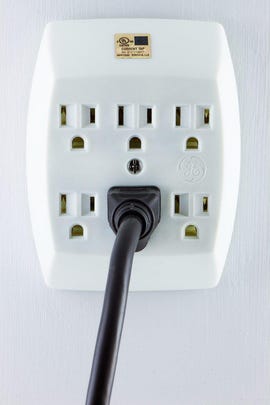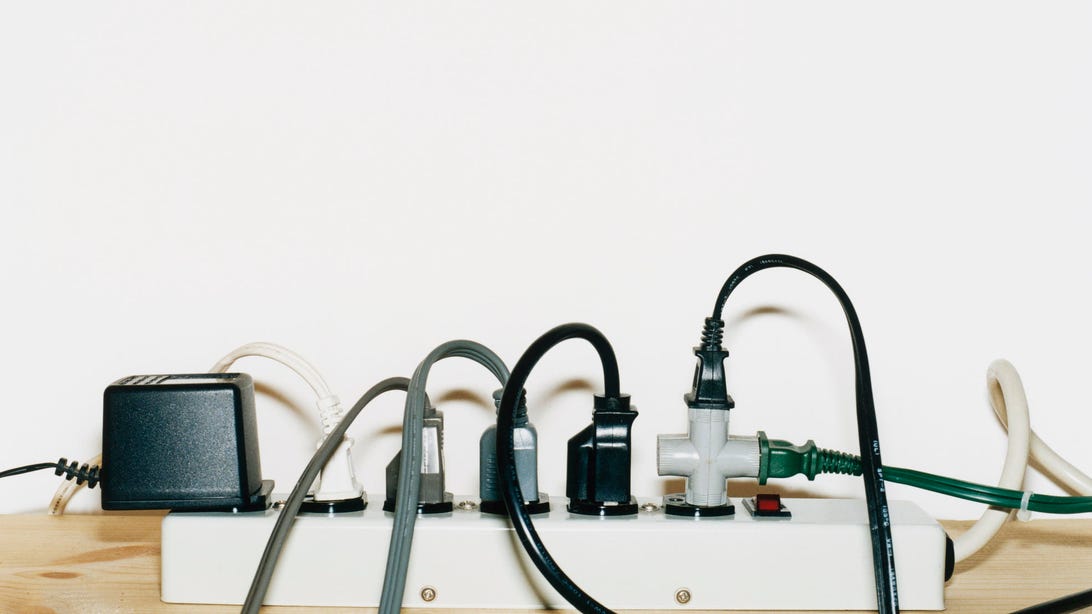Get more use out of your outlets and stay safe while doing it.
There are only two power outlets in my bedroom, and both are hidden behind furniture. That means I rely on power strips to plug in my phone charger, Kindle charger, laptop charger, alarm clock, lamps, TV, sewing machine, Chromecast and the list just keeps going.
If, like me, your outlets are at capacity, there are a few smart (and safe!) solutions you can employ.
Safety first and always
First and foremost, electrical outlets can pose a safety risk. An overloaded power outlet can cause a tripped circuit breaker, increase your risk for electrocution, or start a fire. You want to be mindful of how many things you are plugging in, and what they are.
According to the US National Fire Protection Association (NFPA), products that generate heat, such as hair dryers, space heaters, toasters or crock pots, should always be plugged directly into the electrical outlet. They pull too much power to safely use with a power strip or extension cord.
The Electrical Safety Foundation International and the NFPA both agree that temporary solutions, such as power strips and extension cords, should not be used long-term. The safest way to get access to more electricity in any part of your home is to hire an electrician to install new power outlets.
But, as any renter knows, that's not always doable. Read on for a few ways to cope with not having enough outlets when you can't get more.
At the plug

Outlet taps add more receptacles right at the wall outlet.
Now that we've covered the safety precautions, let's talk about ways to free up some outlet space. One of your best bets is an outlet tap, which plugs into and covers your existing outlet to add more receptacles.
They are commonly available in three- and six-outlet configurations, and some even offer USB ports to charge your devices. Look for outlet taps that have surge protection, which help protect your electronics from damaging power surges.
Get some distance
If the problem is that your wall outlets are just out of reach and you need something to bridge the gap while also adding more receptacles, a power strip is the right tool for the job.
They come in many different shapes, sizes and cord lengths, generally from 2 feet to 25 feet. You probably have several already in your home, but do you know the safety precautions you should take when using them?
Power strip safety tips
- Do not let any flammable material, including pillows, sheets or clothes, cover your power strips. They need adequate airflow to prevent overheating.
- Likewise, avoid wedging them behind furniture that does not give them airflow, like a dresser.
- Do not "daisy-chain" power strips together or plug a power strip to an extension cord to get extra length or outlet space.
- Keep the area around the power strip clean of dust, which can catch fire from electrical sparks.
Even farther out
If you need to plug in just one item, say a pendant lamp in a corner or your laptop charger that just won't reach, it's time to get an extension cord.
While shopping, know exactly what you need to use the cord for and buy accordingly. Thinner indoor extension cords should never be used outside, as they're not durable enough and can fray.
Also, be sure that the cord can handle the power needs of what you're plugging into it. For most household applications, such as plugging in a lamp or a computer charger, an extension cord that can handle up to 13 amps should suffice.
To figure out exactly how many amps your DC-powered item uses, look for the wattage and volts it uses, which is usually stamped or printed on the product. Divide the watts by the volts, and you have the amps.
Stay safe with extension cords
- Do not run extension cords under rugs. Foot traffic can damage the wiring in the cord, which then can spark and cause a fire.
- Replace any old extension cords, or those that show any signs of wear. Fraying wires are a fire hazard.
- Do not use extension cords for heat-producing appliances.
For more household how-tos and tips, check out CNET's Guide to Smart Living.
